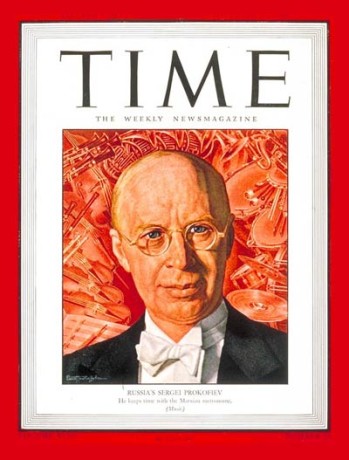When Andrew Lloyd Webber recently told a group of teenage rock musicians on Broadway that he wanted to talk about the music of Sergei Prokofiev rather than his own musicals, he was the latest in a line of pop and rock artists to confess that they’re bowled over by the work of a Russian classical master who died in 1953.
For different people at different times, Prokofiev’s music is an epiphany, a puzzlement, a punch in the face, or a laugh riot. For almost nobody is it a snorer, the way that much “serious” or “classical” music can be. And Prokofiev will be all around the Washington area in the spring of 2016. No fewer than six major concert organizations are presenting a total of seven events with some or all of the program devoted to Prokofiev’s music.
Most of the featured performers coming here from all over the world to perform Prokofiev are young, and that can’t be an accident. Born in 1891 in what is now Ukraine and trained at the St. Petersburg Conservatory, Sergei Prokofiev straddled the Czarist and Soviet eras of Russian history. In the process he developed a variety of musical styles but with a single constant of indomitable and sometimes demonic energy.
Prokofiev lived for periods of time, mostly in the 1920s, in New York and Paris, reconnecting with fellow Russian émigré and ballet impresario Sergei Diaghilev and meeting American jazz, Broadway and concert hall legend George Gershwin. Harlow Robinson’s biography credits one of Prokofiev’s operas as being reflected in Leonard Bernstein’s Candide and many of Stephen Sondheim’s musicals, not least for the spicy “wrong notes” that both Bernstein and Sondheim loved to throw into their music to indicate tension, ambiguity or irony. Prokofiev’s music was often ironic to the point of mockery. One of his suites of short piano pieces is even called Sarcasms.
When Prokofiev died on the same day as Joseph Stalin, he left a distinct legacy for all future Russian-born young musicians, especially those who travel far and wide. That will be on display next Monday evening, March 14, when one of the new global superstars of classical music, pianist Daniil Trifonov, performs Prokofiev’s Piano Concerto No. 3 with the Montreal Symphony Orchestra at the Kennedy Center. Prokofiev churned out this half-hour stemwinder featuring unpredictable but always mesmerizing piano runs bouncing off the orchestra at age 30, and premiered it himself with the Chicago Symphony Orchestra in December 1921.

Daniil Trifonov, who just turned 25, pairs his spectacular technique with unusual interpretive insight and a distinctive manner at the piano that seems to afford a new millenials’ viewpoint on this art form. As a taste, here’s Trifonov’s performance of Prokofiev’s more-compact but also sparkling Piano Concerto No. 1 with legendary conductor Valery Gergiev in the opulent Great Hall of the Moscow Conservatory. Check out the young pianist’s transcendent expression when he finishes the opening passage of the concerto right before the 1-minute mark:
https://www.youtube.com/watch?v=s9t-kCzCKMU
The piano was Prokofiev’s foremost means of expression, and perhaps the biggest highlight of the season comes on Tuesday, May 3 when veteran Israeli-American pianist Yefim Bronfman (who was born in the Soviet Union) performs Prokofiev’s landmark War Sonatas at the Library of Congress. Comprising Nos. 6, 7 and 8 of Prokofiev’s nine completed piano sonatas, this group reflects a period from 1938 to 1944 when Prokofiev had to deal with the Stalinist purges, his own personal upheavals, and the ongoing epic of the Russian battle against Nazi Germany.
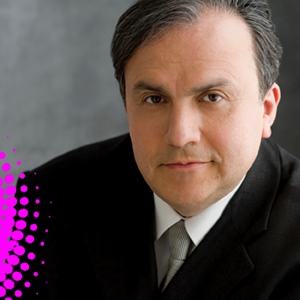
The three sonatas add up to 10 individual movements, and if you don’t go running and screaming in horror out of the library’s Coolidge Auditorium after the first movement of the Sixth Sonata, you should do fine with the other nine. The opening minute alone of the Sixth Sonata is alarming, and Bronfman, a Prokofiev specialist, is known for his ability to play very loudly. Toward the end of this first movement, if you think you hear ticking clocks, tolling bells, and falling bombs, be assured that Prokofiev probably meant you to.
But the mood varies throughout the rest of the Sixth Sonata, where a fleet if ironic scherzo and a quirky waltz keep listeners entertained long enough to get them to the first movement of the Seventh Sonata. In that movement, scholars debate whether Prokofiev is depicting pianistic boots on the ground marching toward the Nazis or marching in the other direction toward your house to whisk you off to Stalin’s Gulag. Still, Prokofiev’s payoff for listeners comes either at the beginning of the Eighth Sonata, which is broodingly reflective, or certainly by the last movement of the Eighth Sonata, which is openly victorious.
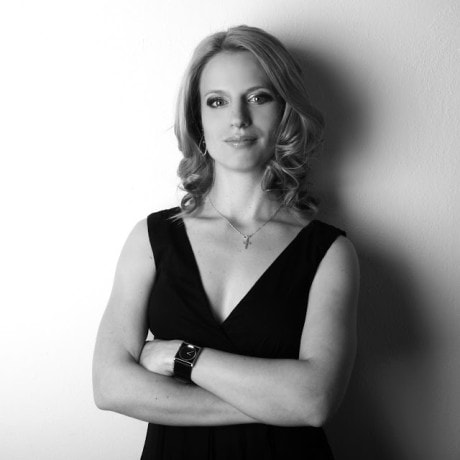
I’m certain this will be one classical concert which will see the bare minimum of coughing and dozing! That will also likely be the case a month later, when a much younger pianist, a rising star from the Czech Republic named Veronika Böhmová, appears at the Czech Embassy under the auspices of the Embassy Series. She will also perform Prokofiev’s Sonata No. 7, along with some very ambitious music by Spanish, French and other Russian composers.
This period in history also gets a hearing on Saturday, April 30 when the Baltimore Symphony Orchestra performs Prokofiev’s Symphony No. 5, which debuted in January 1945 in Moscow after the tide of war had turned and victory appeared certain. The most popular of Prokofiev’s seven complete symphonies, the Fifth features long if unpredictably curvy melodies, many splashes of Prokofiev’s typically rapid nervous energy, and occasional brassy descents into tortured fear but with redemption just around the corner. By the end of that year Prokofiev would appear on the cover of Time magazine in the glow of warm American-Soviet relations right after the war, all to have it collapse by the end of the decade in the wake of the Iron Curtain, the Berlin Airlift, and the Korean War.
Time said in its cover story that Prokofiev’s record albums were then outselling Mozart’s in the United States. Among those records being whisked off the store shelves in 1945 were a very different composition by Prokofiev, and one that is shocking to recognize comes from the same pen as the War Sonatas. It’s the popular children’s story Peter and the Wolf, composed by Prokofiev for an actual children’s theater in Moscow not long after he returned to his home country to stay after his Paris period.
Still popular today, Peter and the Wolf will be performed live by the Baltimore Symphony Orchestra this coming Saturday, March 12 at Strathmore at both 11 a.m. and 1 p.m. Prokofiev’s music here is a rare combination of open accessibility and artistic sophistication, and introduces kids to the idea that distinct musical instruments and repeated themes can be associated with individual people (and animals) as well as moods, emotions and turns of a story’s plot.
Perhaps the most innovative Prokofiev-related event comes on April 3 in the Sunday afternoon concert series at the Phillips Collection. Prokofiev wrote two contrasting full-length sonatas for violin and piano, one full of foreboding and the other sunnier in spirit but also musically adventurous in various angular and skittering ways. This brighter sonata actually originated as his Sonata for Flute and Piano, and musicians ever since have taken the cue that if the same piece can be performed on either a flute or a violin, it can also be adapted to new instruments.
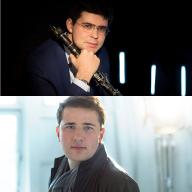
Photo courtesy of The Phillips Collection.
That’s the idea behind 30-year-old Russian virtuoso clarinetist Valentin Uryupin performing his own adaptation of this sonata on a program filled with harmonically advanced music for clarinet. Joining Uryupin will be multi-award-winning Ukrainian-American pianist Stanislav Khristenko in his return to the popular Phillips concert series.
Something of the same idea is behind an appearance at The Kennedy Center Terrace Theater of a superb 18-year-old Chinese viola player named Ziyu Shen on Tuesday, April 19, where she will perform viola-and-piano adaptations of parts of a ballet Prokofiev wrote to the story of Romeo and Juliet. It remains today the principal ballet treatment of the Shakespearean classic.
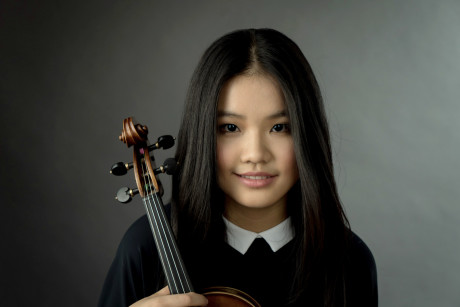
See below for concert and ticket information for all seven events in order of their occurrence. But first take a 3½-minute listen to the incredible final movement of the Piano Sonata No. 7, to which Prokofiev gave a unique, single-word tempo marking of Precipitato. It really doesn’t need translation – you’ll see why. And you’ll also see why it’s the piece that Andrew Lloyd Webber and so many other contemporary artists bring up first when they confess their Prokofiev obsession. Make sure to fasten your seatbelt. It’s quite a ride.
Peter and the Wolf will be performed by the Baltimore Symphony Orchestra at The Music Center at Strathmore, on Saturday, March 12, 2016 at 11 a.m. and 1 p.m. See ticket information here.
Prokofiev’s Piano Concerto No. 3 will be performed by pianist Daniil Trifonov with the Montreal Symphony Orchestra, presented by Washington Performing Arts, at The Kennedy Center Concert Hall, on Monday, March 14, 2016 at 7 p.m. The concert also includes music by Debussy and Stravinsky. See ticket information here.
Prokofiev’s Sonata for Flute and Piano arranged for clarinet and piano will be performed by clarinetist Valentin Uryupin and pianist Stanislav Khristenko at the Phillips Collection, on Sunday, April 3, 2016 at 4 p.m. The concert also includes music by Poulenc, Schubert and Widmann. See ticket information here.
Selections from Prokofiev’s ballet Romeo and Juliet arranged for viola and piano will be performed by violist Ziyu Shen and pianist Jessica Osborne, presented by Young Concert Artists, at The Kennedy Center Terrace Theater, on Tuesday, April 19, 2016 at 7 p.m. The concert also includes music by Brahms and others. See ticket information here.
Prokofiev’s Symphony No. 5 will be performed by the Baltimore Symphony Orchestra at The Music Center at Strathmore, on Saturday, April 30, 2016 at 8 p.m. The concert also includes music by Tchaikovsky and Victoria Borisova-Ollas. See ticket information here.
Prokofiev’s War Sonatas (Piano Sonatas Nos. 6, 7 and 8) will be performed by pianist Yefim Bronfman at the Coolidge Auditorium of the Library of Congress, on Tuesday, May 3, 2016 at 8 p.m. See ticket information here.
The Piano Sonata No. 7 will be performed by pianist Veronika Böhmová, presented by the Embassy Series at the Embassy of the Czech Republic, on Thursday, June 9, 2016 at 7:30 p.m. The concert also includes music by Albeniz, Ravel and Shostakovich. See ticket information here.


